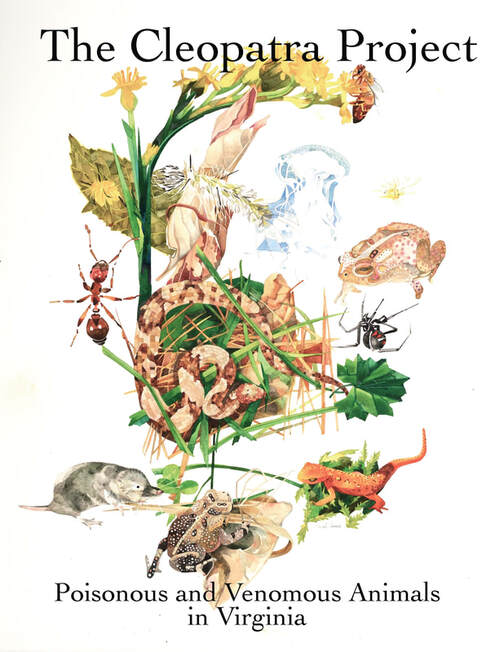
The Cleopatra Project: Poisonous and Venomous Animals in Virginia
 The Cleopatra Project cover art by Trish Crowe.
The Cleopatra Project cover art by Trish Crowe.
The Cleopatra Project is a multi-chapter Virginia Master Naturalist educational project conducted in partnership with the University of Virginia School of Medicine, Blue Ridge Poison Center and Virginia Master Naturalists. The project, initiated in summer 2021 by current and former members of the Old Rag Chapter, is modeled after The Socrates Project on poisonous plants in Virginia which was produced in 2020.
The Cleopatra Project, broader in scope and complexity than The Socrates Project, is the collaborative work of 8 VMN chapters and peer review experts affiliated with Virginia’s higher education institutions, museums and scientific societies. Each of the 32 animal entries–ranging from Ants to Wasps & Bees–includes a description of the animal, its habitat and likely geographic range in Virginia, the source of poison or venom, potential physical symptoms, and possible animal “look-alikes.” The publication emphasizes the vital role that poisons and venoms play for some animals in gaining food, protection from predators, and defense of their territory and young– in order that readers learn to live respectfully and safely with these fellow inhabitants of Virginia. An understanding of the habitat and habits of these animals protects both animals in the wild and humans.
In 2022, Old Rag Master Naturalists Cleopatra participants contributed over 957 volunteer hours toward production of this 106-page publication as authors, photographers, project managers and editors. Old Rag Chapter’s contributors and project leaders included Kathleen Aucoin, Bonnie Beers, Brenda Clements Jones and Don Hearl, as well as past members Alfred Goossens (now a member of the Rivanna chapter) and Peg Clifton. Certified members from 8 statewide VMN chapters–10 authors, 2 peer reviewers and 8 photographers—also contributed to the publication. VMN chapters represented in this collaborative project are: Banshee Reeks, Central Virginia, High Knob, New River Valley, Old Rag, Rivanna, Roanoke, Southwestern Piedmont.*
A limited number of printed copies of The Cleopatra Project will be distributed to health care providers, poison control centers, Virginia school nurses, Virginia State Parks, Shenandoah National Park, and other service centers and organizations in the state with educational missions. Educational presentations, using materials created by the project team, will also be provided to interested groups throughout Virginia. The online version is available at no cost to everyone.
- The Cleopatra Project is now available for free download on the website of The University of Virginia Health’s Blue Ridge Poison Center
- Also available online is the companion document The Socrates Project, which addresses poisonous plants that may be encountered in Virginia: free download on the website of The University of Virginia Health’s Blue Ridge Poison Center
- The Cleopatra Project in the news: UVa’s 1/3/23 Cleopatra Press Release; Charlottesville NBC 29 News report of 1/3/23.
- Contact for additional information: Cleopatra.Socrates@gmail.com